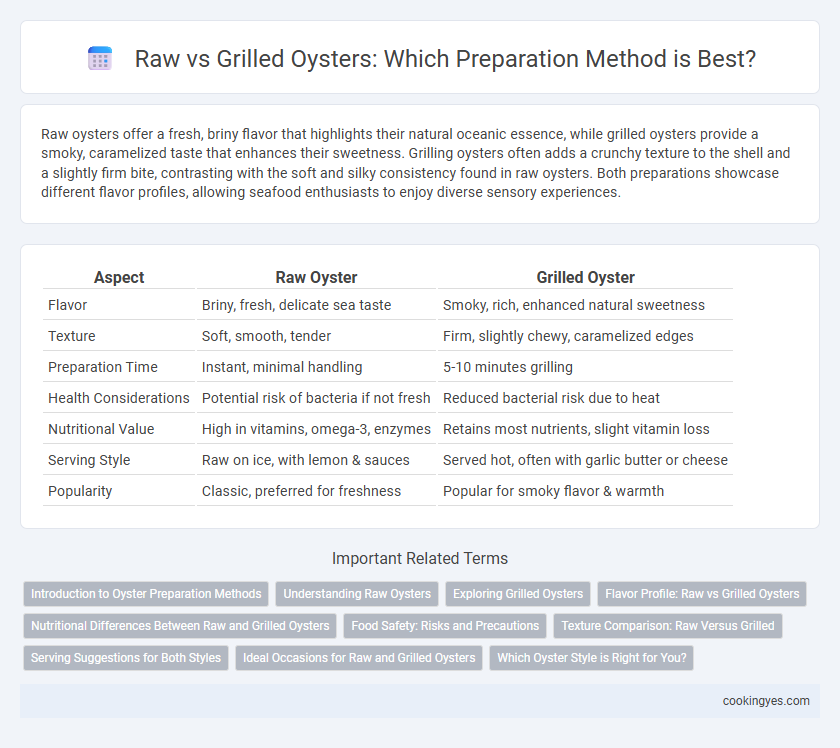Raw oysters offer a fresh, briny flavor that highlights their natural oceanic essence, while grilled oysters provide a smoky, caramelized taste that enhances their sweetness. Grilling oysters often adds a crunchy texture to the shell and a slightly firm bite, contrasting with the soft and silky consistency found in raw oysters. Both preparations showcase different flavor profiles, allowing seafood enthusiasts to enjoy diverse sensory experiences.
Table of Comparison
| Aspect | Raw Oyster | Grilled Oyster |
|---|---|---|
| Flavor | Briny, fresh, delicate sea taste | Smoky, rich, enhanced natural sweetness |
| Texture | Soft, smooth, tender | Firm, slightly chewy, caramelized edges |
| Preparation Time | Instant, minimal handling | 5-10 minutes grilling |
| Health Considerations | Potential risk of bacteria if not fresh | Reduced bacterial risk due to heat |
| Nutritional Value | High in vitamins, omega-3, enzymes | Retains most nutrients, slight vitamin loss |
| Serving Style | Raw on ice, with lemon & sauces | Served hot, often with garlic butter or cheese |
| Popularity | Classic, preferred for freshness | Popular for smoky flavor & warmth |
Introduction to Oyster Preparation Methods
Oyster preparation methods vary widely, with raw and grilled being the most popular choices that highlight distinct flavor profiles and textures. Raw oysters deliver a fresh, briny taste and a smooth, tender texture, preserving the ocean's natural essence, while grilled oysters develop a smoky, rich flavor with a firmer texture due to the heat caramelizing the briny juices. Understanding these methods enhances the culinary experience by selecting preparation styles that suit individual taste preferences and enhance the oyster's natural qualities.
Understanding Raw Oysters
Raw oysters offer a fresh, briny flavor profile prized by seafood enthusiasts, with natural minerals and subtle sweetness preserved. Consuming raw oysters requires careful handling to avoid foodborne pathogens like Vibrio, necessitating sourcing from reputable suppliers and maintaining proper refrigeration. Understanding the texture and taste differences, raw oysters provide a tender, slightly chewy experience distinct from the firmer, smoky notes developed during grilling.
Exploring Grilled Oysters
Grilled oysters offer a smoky, charred flavor that enhances the briny sweetness of fresh oysters, creating a more robust and complex taste profile compared to raw oysters. The grilling process slightly cooks the oyster, which can bring out natural umami and caramelized notes while maintaining its juicy texture. This preparation method is favored for its ability to combine rustic, outdoor cooking elements with a sophisticated, gourmet seafood experience.
Flavor Profile: Raw vs Grilled Oysters
Raw oysters deliver a fresh, briny flavor with a creamy, smooth texture that highlights the ocean's natural salinity. Grilled oysters develop a smoky, charred taste with enhanced sweetness and firmer meat, offering a richer, more complex flavor profile. The cooking process caramelizes natural sugars and intensifies umami, creating a distinctive contrast to the clean, delicate essence of raw oysters.
Nutritional Differences Between Raw and Grilled Oysters
Raw oysters retain higher levels of essential vitamins such as B12 and niacin, as well as omega-3 fatty acids crucial for heart health. Grilling oysters can reduce water-soluble nutrients and slightly lower omega-3 content due to heat exposure, but it enhances mineral availability like zinc and iron. Both preparation methods provide high-quality protein and essential minerals, though raw oysters offer superior nutritional density in heat-sensitive nutrients.
Food Safety: Risks and Precautions
Raw oysters pose higher risks of bacterial contamination, particularly from Vibrio vulnificus, which can cause severe foodborne illnesses. Grilling oysters at an internal temperature of 145degF (63degC) effectively kills harmful pathogens, making this method safer for consumption. Proper handling, storage below 40degF (4degC), and sourcing from reputable suppliers are essential precautions to minimize food safety risks regardless of preparation style.
Texture Comparison: Raw Versus Grilled
Raw oysters offer a smooth, silky texture that bursts with briny juice, providing a fresh and tender mouthfeel. Grilled oysters develop a firmer, slightly chewy texture with a smoky char that enhances their natural flavors while adding subtle caramelization. The contrast between the velvety softness of raw oysters and the robust, bite-resistant quality of grilled oysters highlights distinct culinary experiences.
Serving Suggestions for Both Styles
Raw oysters are best served chilled on a bed of crushed ice, accompanied by lemon wedges, mignonette sauce, or cocktail sauce to enhance their natural briny flavor. Grilled oysters benefit from toppings like garlic butter, herbs, and Parmesan cheese which melt and infuse the smoky taste, making them ideal for serving as an appetizer or alongside grilled seafood dishes. Both preparation styles pair well with crisp white wines or light beers to complement their unique textures and flavors.
Ideal Occasions for Raw and Grilled Oysters
Raw oysters are ideal for elegant gatherings or seafood tasting events where freshness and subtle flavors are appreciated. Grilled oysters suit casual barbecues and outdoor parties, offering a smoky, warm option that enhances bold seasonings. Both preparations cater to different palates and occasions, maximizing oyster versatility.
Which Oyster Style is Right for You?
Raw oysters offer a fresh, briny flavor with a smooth, creamy texture, ideal for those who enjoy delicate seafood tastes and nutrient-rich benefits like zinc and omega-3 fatty acids. Grilled oysters provide a smoky, robust flavor with a firmer texture, enhanced by seasonings and melted butter, appealing to those who prefer a cooked, savory experience. Choosing between raw and grilled oysters depends on your taste preference for pure, natural seafood essence versus a bold, cooked flavor profile.
Raw vs Grilled for oyster preparation Infographic

 cookingyes.com
cookingyes.com